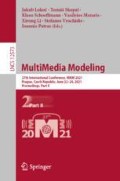Abstract
The recent advances in multimedia modeling with deep learning methods have significantly affected remote sensing applications, such as canopy height mapping. Estimating canopy height maps in large-scale is an important step towards sustainable ecosystem management. Apart from the standard height estimation method using LiDAR data, other airborne measurement techniques, such as very high-resolution passive airborne imaging, have also shown to provide accurate estimations. However, those methods suffer from high cost and cannot be used at large-scale nor frequently. In our study, we adopt a neural network architecture to estimate pixel-wise canopy height from cost-effective spaceborne imagery. A deep convolutional encoder-decoder network, based on the SegNet architecture together with skip connections, is trained to embed the multi-spectral pixels of a Sentinel-2 input image to height values via end-to-end learned texture features. Experimental results in a study area of 942 \(\mathrm{km}^2\) yield similar or better estimation accuracy resolution in comparison with a method based on costly airborne images as well as with another state-of-the-art deep learning approach based on spaceborne images.
Access this chapter
Tax calculation will be finalised at checkout
Purchases are for personal use only
Notes
- 1.
For example, Samaria’s Data Cube is a tool for satellite data users to monitor and evaluate land resources and land change. http://datacube.iti.gr/.
References
Badrinarayanan, V., Handa, A., Cipolla, R.: SegNet: A Deep Convolutional Encoder-Decoder Architecture for Robust Semantic Pixel-Wise Labelling, May 2015. http://arxiv.org/abs/1505.07293
Boutsoukis, C., Manakos, I., Heurich, M., Delopoulos, A.: Canopy height estimation from single multispectral 2D airborne imagery using texture analysis and machine learning in structurally rich temperate forests. Remote Sens. 11(23) (2019). https://doi.org/10.3390/rs11232853. www.mdpi.com/journal/remotesensing
Cailleret, M., Heurich, M., Bugmann, H.: Reduction in browsing intensity may not compensate climate change effects on tree species composition in the Bavarian Forest National Park. For. Ecol. Manag. 328, 179–192 (2014)
Dubayah, R., et al.: The global ecosystem dynamics investigation: high-resolution laser ranging of the earth’s forests and topography. Sci. Remote Sens. 1, 100002 (2020). https://doi.org/10.1016/j.srs.2020.100002
Goetz, S., Steinberg, D., Dubayah, R., Blair, B.: Laser remote sensing of canopy habitat heterogeneity as a predictor of bird species richness in an eastern temperate forest, USA. Remote Sens. Environ. 108(3), 254–263 (2007). https://doi.org/10.1016/j.rse.2006.11.016
Kaiser, Ł., Gomez, A.N., Chollet, F.: Depthwise separable convolutions for neural machine translation. In: 6th International Conference on Learning Representations, ICLR 2018 - Conference Track Proceedings. International Conference on Learning Representations, ICLR (2018)
Lang, N., Schindler, K., Wegner, J.D.: Country-wide high-resolution vegetation height mapping with Sentinel-2. Remote Sens. Environ. 233 (2019). https://doi.org/10.1016/j.rse.2019.111347. https://arxiv.org/abs/1904.13270
Mitchell, A.L., Rosenqvist, A., Mora, B.: Current remote sensing approaches to monitoring forest degradation in support of countries measurement, reporting and verification (MRV) systems for REDD+. Carbon Balance Manag. 12(1), 1–22 (2017). https://doi.org/10.1186/s13021-017-0078-9
Petrou, Z.I., Tarantino, C., Adamo, M., Blonda, P., Petrou, M.: Estimation of vegetation height through satellite image texture analysis. In: ISPRS - International Archives of the Photogrammetry, Remote Sensing and Spatial Information Sciences XXXIX-B8, pp. 321–326 (2012). https://doi.org/10.5194/isprsarchives-xxxix-b8-321-2012. http://www.academia.edu/download/43548529/isprsarchives-XXXIX-B8-321-2012.pdf
Petrou, Z.I., Manakos, I., Stathaki, T., Mucher, C.A., Adamo, M.: Discrimination of vegetation height categories with passive satellite sensor imagery using texture analysis. IEEE J. Sel. Top. Appl. Earth Obs. Remote Sens. 8(4), 1442–1455 (2015). https://doi.org/10.1109/JSTARS.2015.2409131. https://ieeexplore.ieee.org/abstract/document/7061969/
Ronneberger, O., Fischer, P., Brox, T.: U-Net: convolutional networks for biomedical image segmentation. In: Navab, N., Hornegger, J., Wells, W.M., Frangi, A.F. (eds.) MICCAI 2015. LNCS, vol. 9351, pp. 234–241. Springer, Cham (2015). https://doi.org/10.1007/978-3-319-24574-4_28
Rußwurm, M., Koerner, M.: Multi-temporal land cover classification with sequential recurrent encoders. ISPRS Int. J. Geo-Inf. 7(4), 129 (2018). https://doi.org/10.3390/ijgi7040129. http://www.mdpi.com/2220-9964/7/4/129
Silveyra Gonzalez, R., Latifi, H., Weinacker, H., Dees, M., Koch, B., Heurich, M.: Integrating LiDAR and high-resolution imagery for object-based mapping of forest habitats in a heterogeneous temperate forest landscape. Int. J. Remote Sens. 39(23), 8859–8884 (2018). https://doi.org/10.1080/01431161.2018.1500071. https://www.tandfonline.com/action/journalInformation?journalCode=tres20
Wang, X., Ouyang, S., Sun, O.J., Fang, J.: Forest biomass patterns across northeast China are strongly shaped by forest height. Forest Ecol. Manag. 293, 149–160 (2013). https://doi.org/10.1016/j.foreco.2013.01.001
Acknowledgements
This study has been partially funded and supported by the European Union’s Horizon 2020 innovation program under Grant Agreement No. 820852, e-shape (https://e-shape.eu/). LIDAR data was granted by the Cross-border cooperation programme Czech Republic–Bavaria Free State ETC goal 2014–2020, the Interreg V project No. 99 “Přeshranični mapovani lesnich ekosystemů – cesta ke společnemu managementu NP Šumava a NP Bavorsky les /Grenzuberschreitende Kartierung der Waldokosysteme – Weg zum gemeinsamen Management in NP Sumava und NP Bayerischen Wald”. We acknowledge the support of the “Data Pool Initiative for the Bohemian Forest Ecosystem” data-sharing initiative of the Bavarian Forest National Park.
Author information
Authors and Affiliations
Corresponding author
Editor information
Editors and Affiliations
Rights and permissions
Copyright information
© 2021 Springer Nature Switzerland AG
About this paper
Cite this paper
Alagialoglou, L., Manakos, I., Heurich, M., Červenka, J., Delopoulos, A. (2021). Canopy Height Estimation from Spaceborne Imagery Using Convolutional Encoder-Decoder. In: Lokoč, J., et al. MultiMedia Modeling. MMM 2021. Lecture Notes in Computer Science(), vol 12573. Springer, Cham. https://doi.org/10.1007/978-3-030-67835-7_26
Download citation
DOI: https://doi.org/10.1007/978-3-030-67835-7_26
Published:
Publisher Name: Springer, Cham
Print ISBN: 978-3-030-67834-0
Online ISBN: 978-3-030-67835-7
eBook Packages: Computer ScienceComputer Science (R0)

